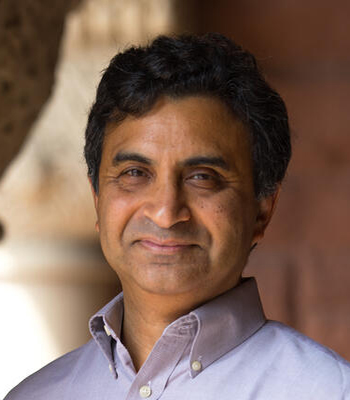

The Center for Risk and Economic Analysis of Terrorism Events (CREATE) is proud to announce Milind Tambe is the first recipient of the CREATE Detlof von Winterfeldt Outstanding Research Award. Dr. Tambe is the Gordon McKay Professor of Computer Science at Harvard University, where he also serves as the Director of the Center for Research in Computation and Society. He was one of the original researchers at CREATE, beginning in 2004 and continuing until his departure for Harvard in 2018. He is now contributing as one of CREATE’s 14 External Senior Research Fellows.
The Award is named in honor of Professor Detlof von Winterfeldt, a CREATE co-founder who served two terms as its Director and has performed outstanding research under its auspices. In addition to honoring Professor von Winterfeldt for his leadership of CREATE and commitment to high research standards, the other main purposes of this Award are to: reward and honor those who have also contributed high-quality and impactful research at CREATE, and to serve as an inspiration to the next generation of researchers. Three criteria are applied in the selection process: 1) scholarly contributions in terms of research quality, 2) impacts on decision-making and institutional operations, and 3) research inspiration and mentoring.
Professor von Winterfeldt remarked: “I am extremely pleased that Milind was selected as the first winner of this award. Milind joined CREATE shortly after it was funded, and his scholarly research and path-breaking applications of AI and game theory put CREATE on the map as a leader of impactful DHS research.”
Professor Tambe noted, “During my time at CREATE, I saw it as a tremendous gift for interdisciplinary research that brought together disciplines including AI, Operations Research, Public Policy, Psychology, Public Safety and Security, and many others. It uniquely fostered a problem-centered or use-centered approach to research. It emphasized the importance of understanding true domain needs from experts before offering solutions, i.e., the importance of immersion in the domain. And it inspired an environment of research that would generate results that are impactful in the real world.”
He added: “CREATE introduced me to Professor Detlof von Winterfeldt’s truly generous and nurturing leadership. I deeply appreciate his expertise in building a great interdisciplinary research team, and inspiring the team to achieve real-world impact, aided by real-world domain expertise. I of course appreciate his unwavering support and encouragement of our research, and posing the right questions for us to think about early on in the research. CREATE’s interdisciplinary research culture was a reflection of partnership between Detlof and [CREATE co-founder] Randy Hall.”
CREATE introduced many key scientific challenges to Professor Tambe’s field of research. One specifically focused on how to effectively allocate limited resources to protect airports, ports, waterways, trains, and other critical infrastructure. In addressing this challenge, he and his research team advanced the state of the art in AI and computational game theory – introducing Stackelberg security game models and algorithms – while simultaneously providing pioneering applications of game theory for operational security in the real world. This entire line of security games research began with the ARMOR application for the Los Angeles International Airport: it was the FIRST application of computational game theory for day-to-day operational security. He acknowledges the key role played by USC’s Dr. Erroll Southers, then Chief of Homeland Security and Intelligence for the Los Angeles World Airports Police Department, who posed to CREATE the concrete problem of how to randomize processes to reduce risk and increase security. With his mentorship, ARMOR started operating at LAX in August of 2007. ARMOR used a security game algorithm to provide actual day-to-day optimized (and randomized) schedules for checkpoints and canine patrols at LAX; the program operated for many years, until conditions changed on the ground.
ARMOR opened the door for many actual deployed applications of computational game theory at CREATE, such as IRIS for optimizing allocation of federal air marshals to flights, PROTECT for newer patrolling strategies for the U.S. Coast Guard, and many others. Simultaneously, the security game model introduced in ARMOR laid the foundation for a whole new area of research, with dozens of papers being published by multiple research groups around the world that continue to advance computational game theory building on the ARMOR foundations. There are by now many new applications for security games, including in cybersecurity, protecting of endangered wildlife and fisheries, protecting forests, and others. In fact, unanticipated new applications, including audit games, drug design against viruses, traffic enforcement, software code testing, adversarial machine learning, and others, have also sprung up. Security games work is acknowledged as one of the biggest success stories of the use of computational game theory in the real world.
Professor von Winterfeldt added, “According to our recent benefit-cost analyses of DHS-funded research, two of Milind’s projects, ARMOR and PROTECT, produced a net benefit of over $64 million by saving costs or by increasing security at airports and sea ports.”
Concluded Professor Tambe, “I am very grateful to CREATE for this award, and I am humbled and deeply honored. Really, I am very grateful to CREATE for providing a stimulating research environment and introducing me to amazing research collaborators. In addition to Professor von Winterfeldt, this includes Dr. Erroll Southers, who inspired me and my research team to develop ARMOR and continued encouragement in our research at CREATE. I am also grateful to so many other wonderful colleagues, including Dr. Richard John with whom we have co-authored many papers, Dr. Adam Rose who has been extremely kind in offering guidance on many occasions, Dr. Randy Hall who has been very generous and tremendously supportive of all our research, and many others.”
Key references:
- Tambe, Milind. 2011. Security and Game Theory: Algorithms, Deployed Systems, Lessons Learned. Milind Tambe, Cambridge University Press. Link
- Sinha, Arunesh, Fang, Fei, An, Bo, Kiekintveld, Christopher, and Tambe, Milind. 2018. “Stackelberg Security Games: Looking Beyond a Decade of Success,” In International Joint Conference on Artificial Intelligence (IJCAI). Link
Posted: December 17, 2020
